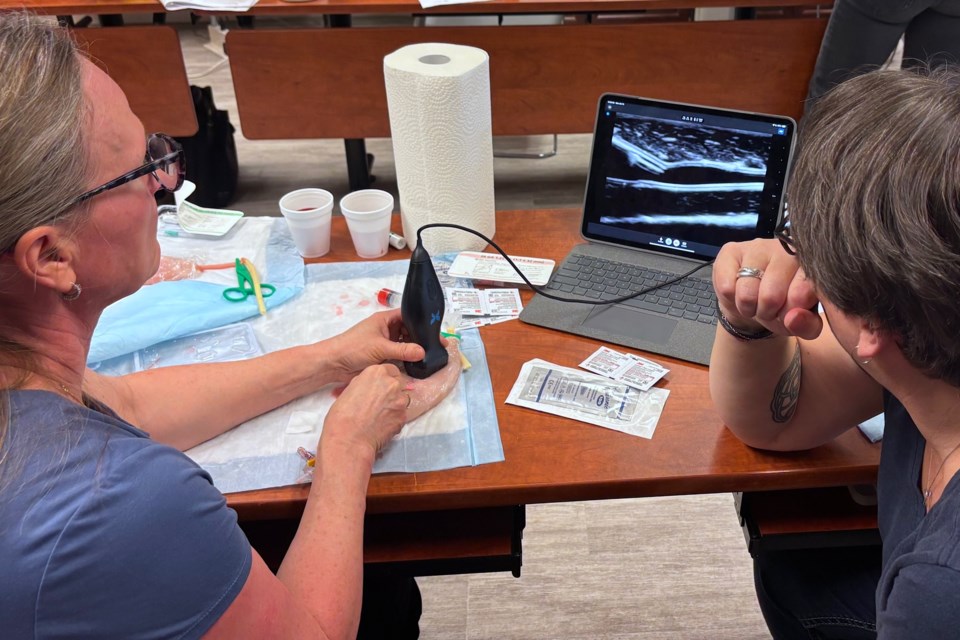SUNDRE – Anybody who has ever needed to be hooked up to an IV is undoubtedly familiar with how unpleasant the process can sometimes be.
“Pretty much everyone’s had an emerge visit at one point or another and needed to have an IV started,” said Dr. Jonathan Somerville, a Sundre physician who works both with the team at Greenwood Family Physicians as well as at the Myron Thompson Health Centre.
Traditionally, health-care professionals have relied on their senses of sight and touch to carry out the procedure that involves inserting a needle into a vein.
“Sometimes, you can’t see it or feel it and then it makes getting an intravenous line a lot more difficult,” said Somerville, adding many patients who at some point required an IV have also experienced the discomfort of repeated attempts that were required to successfully insert the needle.
But courtesy of technological advancements, a relatively new technique that was recently introduced during an advanced skills training course at Sundre’s eSIM lab aims to improve that success rate.
“We are starting to use ultrasound to identify where the vein is,” he said. “It’s kind of an extra way of ensuring that when we start an IV line, we get success and we’re able to establish IV access with as few pokes as possible.”
In other words, the technique substantially improves the accuracy and success rate of finding a vein and inserting the needle with fewer attempts, possibly even just one.
“It’s not always the first go. But the bottom line is it decreases the number of jabs until we get success,” he said.
“A lot of physicians have been doing this kind of as the last resort. So if the nurses are struggling to get IV access, then they’ll call us to come and use the ultrasound to start an IV,” he elaborated.
“We wanted to expand the scope of this skill to our nurses so that they could essentially do that without needing to call a physician over.”
About 10 registered nurses who all work in Sundre participated on Monday, Jan. 13 in the first-ever ultrasound guided IV insertion course that was conducted by Somerville alongside his colleague Dr. Chris Chapman.
“This was a course for our nurses,” said Somerville, adding there was also a resident physician who is currently completing a two-month rotation as part of a rural family medicine residency program.
“We’re always happy to train the students and learners that are here with us.”
The course also played into the push toward establishing Sundre as a rural health-care training campus.
“I wouldn’t say it’s a typical thing happening in a lot of rural places in terms of getting all of the nurses on-boarded with this kind of skill. So, it’s definitely a unique thing for Sundre,” he said.
“This really came out of a local drive,” he said, adding the intent was “to boost the skills of our nurses, and really, their efficiency.”
As part of their standard practice, registered nurses are already trained on administering IVs and more often than not are the ones who carry out the procedure even before the doctor has seen the patient.
“So having the skill (to use the ultrasound) gives them a lot more control,” he said, referring to the option of deploying the technique without requesting a physician.
“That’s why we wanted to run the course for the nurses, so we could train our nurse colleagues to be able to do this on their own.”
The first portion of the course involved using mannequins that were simply chicken breasts with tubing running through them to practise using the ultrasound device to identify a vein and insert the IV all while watching the whole process on a monitor.
“It’s a tricky skill, because most of us, when you’re starting an IV, it requires two hands – you’re stabilizing the person’s arm with one hand and starting the IV with the other,” he said.
“So learning how to hold an ultrasound probe with one hand while starting an IV is definitely a technically challenging skill.”
That requires a level of well-honed, multilateral hand-eye coordination.
“You’re looking at the two-dimensional image of somebody’s veins and you’re trying to convert that to a three-dimensional human as you’re poking the needle in.”
The course lasted for the better part of the day and following the initial practice on mannequins even involved some willing volunteers who served as live models.
“They kind of basically allowed the nurses to look at their arms and identify veins,” he said. “Some of them did practise real-time IV insertion on the volunteers.”
Although it was the first time that specific training session was held, it likely was not the last.
“The course went so well. We had really good feedback from it that I think there’ll be more interest for it.”
Overall, the course was time well spent.
“To get them up and running with this skill is a bit of a time investment, but it will start to carry itself forward after we got enough of them certified to do this on their own,” he said.
“We’re very excited that as we train several batches of nurses through and get more and more nurses in our hospital comfortable with doing this, then they’ll be able to kind of also train each other.”
Chantal Crawford, the health centre’s site manager, expressed appreciation for Somerville’s contribution in facilitating the course.
“This type of training and the vision for all staff to work full scope, and as a multidisciplinary team, to support education is next level,” she said.
“It paves the path to what we are trying to accomplish with becoming a training centre in a new unique way that has us training and supporting each other in a team environment, as we know that is how we work to care for patients.”



